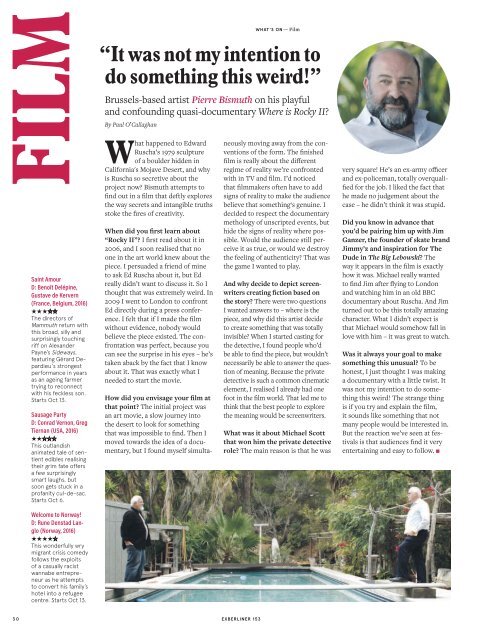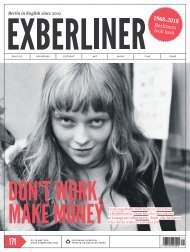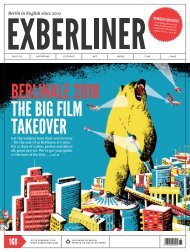EXBERLINER Issue 153, October 2016
You also want an ePaper? Increase the reach of your titles
YUMPU automatically turns print PDFs into web optimized ePapers that Google loves.
Brussels-based artist Pierre Bismuth on his playful<br />
and confounding quasi-documentary Where is Rocky II?<br />
By Paul O’Callaghan<br />
WHAT’S ON — Film<br />
“It was not my intention to<br />
do something this weird!”<br />
Saint Amour<br />
D: Benoît Delépine,<br />
Gustave de Kervern<br />
(France, Belgium, <strong>2016</strong>)<br />
HHH<br />
The directors of<br />
Mammuth return with<br />
this broad, silly and<br />
surprisingly touching<br />
riff on Alexander<br />
Payne’s Sideways,<br />
featuring Gérard Depardieu's<br />
strongest<br />
performance in years<br />
as an ageing farmer<br />
trying to reconnect<br />
with his feckless son.<br />
Starts Oct 13.<br />
Sausage Party<br />
D: Conrad Vernon, Greg<br />
Tiernan (USA, <strong>2016</strong>)<br />
HH<br />
This outlandish<br />
animated tale of sentient<br />
edibles realising<br />
their grim fate offers<br />
a few surprisingly<br />
smart laughs, but<br />
soon gets stuck in a<br />
profanity cul-de-sac.<br />
Starts Oct 6.<br />
What happened to Edward<br />
Ruscha’s 1979 sculpture<br />
of a boulder hidden in<br />
California's Mojave Desert, and why<br />
is Ruscha so secretive about the<br />
project now? Bismuth attempts to<br />
find out in a film that deftly explores<br />
the way secrets and intangible truths<br />
stoke the fires of creativity.<br />
When did you first learn about<br />
“Rocky II”? I first read about it in<br />
2006, and I soon realised that no<br />
one in the art world knew about the<br />
piece. I persuaded a friend of mine<br />
to ask Ed Ruscha about it, but Ed<br />
really didn’t want to discuss it. So I<br />
thought that was extremely weird. In<br />
2009 I went to London to confront<br />
Ed directly during a press conference.<br />
I felt that if I made the film<br />
without evidence, nobody would<br />
believe the piece existed. The confrontation<br />
was perfect, because you<br />
can see the surprise in his eyes – he’s<br />
taken aback by the fact that I know<br />
about it. That was exactly what I<br />
needed to start the movie.<br />
How did you envisage your film at<br />
that point? The initial project was<br />
an art movie, a slow journey into<br />
the desert to look for something<br />
that was impossible to find. Then I<br />
moved towards the idea of a documentary,<br />
but I found myself simultaneously<br />
moving away from the conventions<br />
of the form. The finished<br />
film is really about the different<br />
regime of reality we’re confronted<br />
with in TV and film. I’d noticed<br />
that filmmakers often have to add<br />
signs of reality to make the audience<br />
believe that something‘s genuine. I<br />
decided to respect the documentary<br />
methology of unscripted events, but<br />
hide the signs of reality where possible.<br />
Would the audience still perceive<br />
it as true, or would we destroy<br />
the feeling of authenticity? That was<br />
the game I wanted to play.<br />
And why decide to depict screenwriters<br />
creating fiction based on<br />
the story? There were two questions<br />
I wanted answers to – where is the<br />
piece, and why did this artist decide<br />
to create something that was totally<br />
invisible? When I started casting for<br />
the detective, I found people who’d<br />
be able to find the piece, but wouldn’t<br />
necessarily be able to answer the question<br />
of meaning. Because the private<br />
detective is such a common cinematic<br />
element, I realised I already had one<br />
foot in the film world. That led me to<br />
think that the best people to explore<br />
the meaning would be screenwriters.<br />
What was it about Michael Scott<br />
that won him the private detective<br />
role? The main reason is that he was<br />
very square! He’s an ex-army officer<br />
and ex-policeman, totally overqualified<br />
for the job. I liked the fact that<br />
he made no judgement about the<br />
case – he didn’t think it was stupid.<br />
Did you know in advance that<br />
you’d be pairing him up with Jim<br />
Ganzer, the founder of skate brand<br />
Jimmy’z and inspiration for The<br />
Dude in The Big Lebowski? The<br />
way it appears in the film is exactly<br />
how it was. Michael really wanted<br />
to find Jim after flying to London<br />
and watching him in an old BBC<br />
documentary about Ruscha. And Jim<br />
turned out to be this totally amazing<br />
character. What I didn’t expect is<br />
that Michael would somehow fall in<br />
love with him – it was great to watch.<br />
Was it always your goal to make<br />
something this unusual? To be<br />
honest, I just thought I was making<br />
a documentary with a little twist. It<br />
was not my intention to do something<br />
this weird! The strange thing<br />
is if you try and explain the film,<br />
it sounds like something that not<br />
many people would be interested in.<br />
But the reaction we’ve seen at festivals<br />
is that audiences find it very<br />
entertaining and easy to follow. n<br />
Welcome to Norway!<br />
D: Rune Denstad Langlo<br />
(Norway, <strong>2016</strong>)<br />
HHHH<br />
This wonderfully wry<br />
migrant crisis comedy<br />
follows the exploits<br />
of a casually racist<br />
wannabe entrepreneur<br />
as he attempts<br />
to convert his family’s<br />
hotel into a refugee<br />
centre. Starts Oct 13.<br />
30<br />
<strong>EXBERLINER</strong> <strong>153</strong>


















